実施日 : 2020年02月04日(火) - 05日(水)
Report: Mozu-Furuichi Kofun Group (Osaka) Press Tour
投稿日 : 2020年03月26日
In July 2019, the Mozu-Furuichi Kofun Group located in the cities of Sakai, Habikino and Fujiidera was the first site in Osaka to be registered on the UNESCO World Heritage List.
A press tour (sponsored by the Conference Headquarters for the Promotion of Mozu-Furuichi Kofungun for World Cultural Heritage Inscription; planned and operated by the FPCJ) to this kofun group was held for members of the foreign press, covering the following topics:
Ⅰ. 1600-Year-Old Burial Mounds Preserved in a City of One Million
Ⅱ. Preserving Cultural Properties for the Future Alongside Development
III. Efforts by Local Governments and Businesses After Registration on the World Heritage List
Ⅳ. The Techniques of Modern Knife Artisans with Roots in the Kofun Period
In addition to filming and photographing the kofun from a helicopter, the tour spoke with various people involved with the kofun, including local government officials, archeologists, residents, and business operators.
A total of 10 journalists participated in this tour, from 8 media organizations located in China, France, Hong Kong, Russia, Taiwan, and the US.
*This press tour was sponsored by the Conference Headquarters for the Promotion of Mozu-Furuichi Kofungun for World Cultural Heritage Inscription, and planned and operated by the FPCJ.
*For details on the tour stops, click here to see the tour notice.
Day 1: Tuesday, February 4
【Aerial Photography】
Having arrived at Yao Airport, the journalists got on a helicopter a few at a time and spent approximately 30 minutes filming and photographing kofun of different sizes from the air. After hearing an explanation of the kofun group from Mr. Gen Miyoshi, from the Osaka Prefecture Board of Education Cultural Properties Preservation Division, the group asked numerous questions, such as “Why this (keyhole) shape,” “Do the different sizes of kofun reflect the standing of the person buried there,” “Is there meaning behind the position and sizes of the kofun,” and “Were they influenced by Chinese culture?”




【Nintoku-tenno-ryo Kofun and the Mamoritai’s Activities】
The tour visited the Nintoku-tenno-ryo Kofun, Japan’s largest kofun, which is managed by the Imperial Household Agency. There, they heard from Mr. Toshio Kusano, secretary general of the Nintoku-ryo o Mamoritai volunteer group, about how local residents had cleaned the area around the kofun for generations, and efforts by the local community to protect the kofun. Regarding the kofun being registered on the World Heritage List, Mr. Kusano commented that he was “happy, but also afraid,” saying that they had to figure out how to protect the kofun in a manner worthy of a World Heritage Site, and also how to make it easier for foreign tourists to visit.




【Itasuke Kofun】
Itasuke Kofun in Sakai was saved from destruction due to postwar development through grassroots efforts. Mr. Susumu Miyakawa, a dentist and amateur archaeologist, is one of the citizens who saved the kofun at the last minute. The journalists interviewed him while standing in front of Itasuke Kofun. They listened closely as he explained how, as a student at the time, he decided to protect the kofun, and how they went about preserving the kofun through the activities of citizens. When Mr. Miyakawa explained how the kofun was measured using the length of people’s spread arms when constructed, the journalists spread their arms and lined up to demonstrate the idea. The group also took pictures of him and the concrete bridge that was made for the sake of developing the area, and has been left as a reminder to future generations. The tour then went to the Sakai City Museum, hearing from Mr. Miyakawa about his experiences with the kofun during and after World War II, and about artifacts collected from kofun such as hook-shaped weapons.

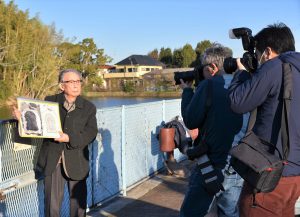


【Sakai City's Haniwa Bucho/CHO (Chief Haniwa Officer)】
At the Sakai City Museum, the tour met with the mascot characters of the three cities that the Mozu-Furuichi Kofun Group is located in, Haniwa Bucho (Sakai), Tsubutan (Habikino), and Manarikun (Fujiidera). The journalists heard from Haniwa Bucho about his creation and efforts working towards registration on the World Heritage List, and efforts to use the kofun to promote tourism now that they have been registered. Haniwa Bucho commented, “With the increased numbers of overseas tourists to Sakai, the city has been working to provide multilingual signage, and has been looking into renovating the museum. Hot air balloons are also being considered as a way to allow people to see the full extent of the kofun.” After the interview, the journalists put on head-mounted displays used at the Sakai City Museum, and experienced the Mozu-Furuichi Kofun Group in VR.




Day 2: Wednesday, February 5
【Tsudo-shiroyama Kofun】
The Tsudo-shiroyama Kofun in Fujiidera is a large keyhole-shaped kofun built in the late fourth century. The main attraction of this kofun is that in addition to viewing it from afar, it is possible to climb on top of the kofun, and see the scenery surrounding it from atop the kofun. The journalists visited the Guidance Center where a replica of the large stone coffin excavated from the kofun in 1912 is exhibited, as well as other burial goods. They asked questions about the relation with religion, connections to the Korean Peninsula, and where haniwa (clay objects) were excavated from. Next, the group climbed atop the kofun and heard from a Fujiidera City official about the city’s efforts to preserve the kofun by purchasing private property.
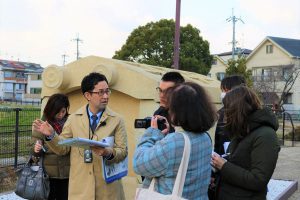
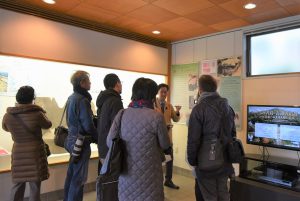


【Habikino City Cultural Property Maintenance and Exhibition Office】
In the cities the Mozu-Furuichi Kofun Group is located in, every day experts work to restore the burial goods excavated from the kofun. The tour visited the Habikino City Cultural Property Exhibition Office, which displays mainly haniwa, earthenware, and accessories that have been restored after being excavated, and spoke with a member of the city's Cultural Properties Preservation Division, Mr. Masahiro Ito, about the meaning behind restoring and displaying cultural properties and about how the objects displayed demonstrate connections with the rest of East Asia. The journalists showed great interest in taking pictures of human-shaped haniwa, metallic gyohai (fish-shaped ornaments), and flower-shaped accessories. The journalists asked questions such as how copper and gold were acquired at the time. The tour then moved to the maintenance room, next to the exhibition space, and were impressed with the detailed work being carried out to such as measuring earthenware for restoration. Mr. Ito commented, “Important sites are designated as historic sites, but for many others once they are excavated when being developed there is no longer the opportunity to visit that site. By keeping records, I would like to spread the knowledge of what was excavated. I would be glad if the World Heritage List registration led to more interest in preserving cultural properties and utilizing them when developing the city.”



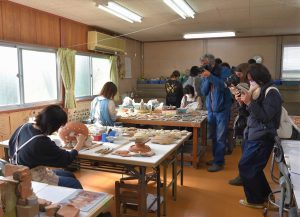
【Okuraya】
Kawachi Konda Haniwa-no-sato Okuraya is a store located in Habikino City, surrounded by multiple kofun such as the Ojin-tenno-ryo Kofun, which provides workshops on making haniwa and sells a diverse assortment of kofun merchandise. The shop was opened in April 2019 by a local printing company, Okura Insatsu Kogyo. The journalists started their visit here by eating Okuraya’s original “haniwa bento” lunches made using kofun and haniwa as a motif. They then heard from company president Mr. Masaaki Yamamoto and employee Ms. Akiko Asano about their desire to stimulate the local community and make kofun into a place people can enjoy more easily, the amount of inbound tourists visiting the store, and “kofun girls” activities through social media and events. The journalists also filmed and photographed a haniwa-making workshop.




【Mizuno Tanrenjo】
Sakai has a long history of blade-making, and is known for its artisans which handcraft one blade at a time. With the increasing worldwide popularity of Japanese cuisine, chefs from overseas have also begun visiting Sakai for its knives. The root of the knife-making techniques in Sakai are said to be in the construction of the Nintoku-tenno-ryo Kofun, with the artisans making iron tools used in its construction moving to Sakai and leading to the development of blacksmithing techniques in the area. The final stop on this tour was Mizuno Tanrenjo, founded around 150 years ago, where the journalists learned how knives are made. The journalists took many pictures of fifth-generation owner Mr. Jun Mizuno as he swung his hammer to forge a knife. During the interview with Mr. Mizuno, the group heard how Mizuno Tanrenjo made the “talisman sickles” decorating the edges of the roof of the five-story pagoda at Horyuji Temple, a National Treasure, and about his efforts to learn the art of blacksmithing. The journalists asked numerous questions, including about where steel was produced and how to learn veteran techniques.

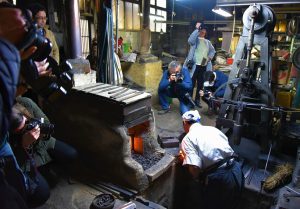


◆Below are some of the reporting produced by the journalists based on this press tour.
▽Xinhua News Agency (China/ News Agency) *Including reprint
「探访日本世界遗产“百舌鸟和古市古坟群”」(Chinese)
(1)http://www.xinhuanet.com/world/2020-02/07/c_1210465185.htm
(2)http://www.xinhuanet.com/asia/2020-02/07/c_1210465185.htm
(3)https://3w.huanqiu.com/a/3458fa/3ww3cNhwVMN?agt=8
(4)http://www.sohu.com/a/371248828_115402
「Ancient tombs in Osaka Province, Japan」(English)
(5)http://www.xinhuanet.com/english/2020-02/06/c_138759447.htm
(6)https://enapp.chinadaily.com.cn/a/202002/06/AP5e3b7cd8a3103a24b1106033.html
(7)http://global.chinadaily.com.cn/a/202002/06/WS5e3b7cd6a310128217275663_1.html
(8)https://www.globaltimes.cn/content/1178695.shtml
「大阪初の世界遺産「百舌鳥・古市古墳群」を訪ねて」(Japanese)
(9)http://jp.xinhuanet.com/2020-02/11/c_138774110_2.htm
(10)https://www.msn.com/ja-jp/news/opinion/大阪初の世界遺産「百舌鳥・古市古墳群」を訪ねて/ar-BBZRSV0
▽Think Hong Kong (Hong Kong/ Online)
「大阪府誕生新的世界文化遺產」
(11)https://www.thinkhk.com/article/2020-03/16/40054.html
「大阪千年古墓土俑上電視爆紅」
(12)https://www.thinkhk.com/article/2020-03/16/40057.html
「源於日本古墳時代的「堺之刃物」」
(13)https://www.thinkhk.com/article/2020-03/16/40058.html



